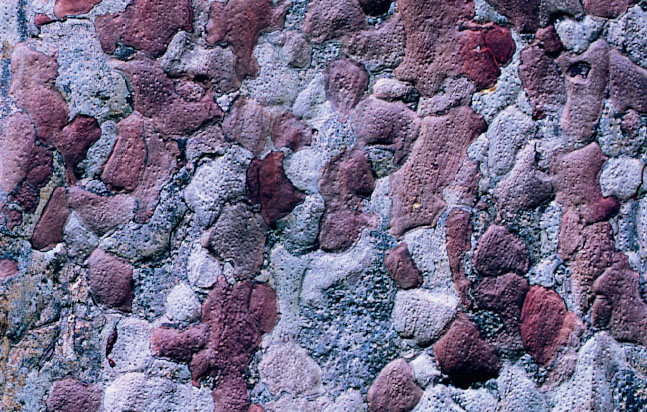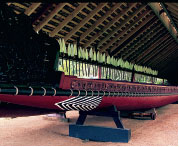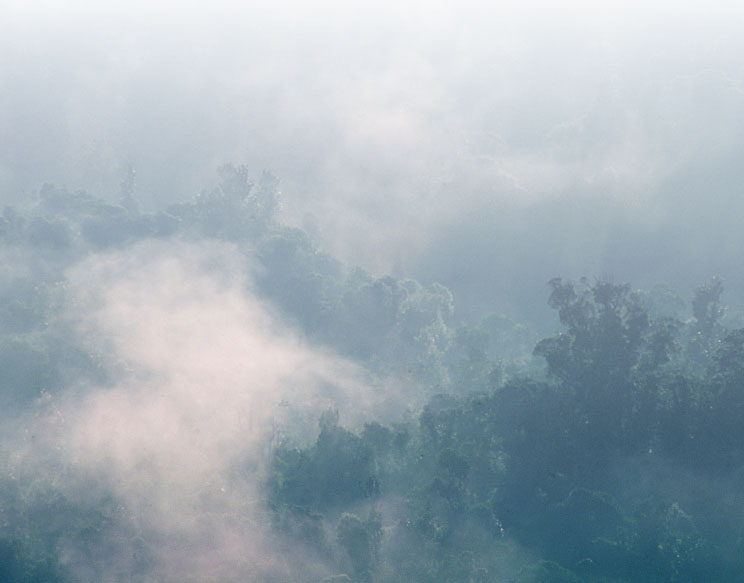
BOTANICAL NAME
Agathis australis
DISTRIBUTION
Northern North Island, New Zealand.
OLDEST KNOWN LIVING SPECIMEN
Te Matua Ngahere in Waipoua Forest: estimated over 2,000 years.
LARGEST SPECIMEN
Tane Mahuta: 45.2m (148ft 5in.); diameter at breast height 4.91m (16ft); total volume 516.7 cu. m (18,250 cu. ft).
RELIGIOUS SIGNIFICANCE
Believed to possess its own spirit, and revered by the Maori people.
MYTHICAL ASSOCIATIONS
Likened by the Maoris to the whale, because of its huge size and the smoothness of its bark.
CONSERVATION STATUS
Classified on the IUCN Red List in 2000 as ‘lower risk’ and ‘conservation-dependent’.

Kauri forest at Waipoua in North Island, New Zealand.
With their massive columnar trunks and elegant tracery of branches, the kauri trees of New Zealand give an unmistakable character to the North Island valleys and ridges they once dominated, and have inspired some who have observed them to liken them to Gothic cathedrals. Clearly distinct from the other trees that make up the subtropical rainforest around them, they rival the giant redwoods of California in size, and the largest individuals alive today are believed to be more than 2,000 years old.

A modern-day example of Maori moko (tattoo). In earlier times, these elaborate designs would have been coloured by a stain made from burnt kauri gum and shark oil.
These giants belong to an extremely ancient family of trees, the Araucariaceae, which were abundant before the coming of the dinosaurs and the break-up of the super-continent Gondwana. Although there are 13 other species and two subspecies of kauri, which grow in the tropical regions of Australia, Melanesia, New Guinea, the Philippines, the Celebes, Borneo, Sumatra and the Malay peninsula, the southern kauri (Agathis australis) is found only in New Zealand. More distant relatives of the kauri include the monkey puzzle and parana pine of South America and the Norfolk Island pine. In the far north of New Zealand’s North Island are swamplands where large kauri trees that were growing some 30–50,000 years ago have been discovered, preserved underwater.

The smooth trunk regularly sheds flakes of bark, preventing the growth of epiphytes.
Before the arrival of Europeans, kauri forest covered an estimated 1.6 million ha. (6177 sq. miles) of New Zealand’s North Island. It was Captain Cook’s excited reference to the forests he saw in 1769 that attracted the first European timber men. Cook (1728–79) noted: ‘The banks of the river were completely clothed with the finest timber my eyes have ever seen.’
The arrival of the timber men, however, was to spell disaster both for the kauri trees and for the Maori people, who revered the trees. What followed was the wholesale destruction of the ancient and majestic kauri forests: in just 150 years they were to shrink to an area of barely 7,455 ha. (29 sq. miles). By the latter half of the twentieth century, however, people had come to appreciate the intrinsic value of the kauri forests once more. Today there are a number of refuges where the remaining giants are protected for posterity.
Kauri trees can grow to an immense size. Although the list of ‘greatest’ trees has changed as new discoveries and measurements have been made, today the tree estimated to have the broadest trunk and to be the oldest is in Waipoua Forest. It is known by its Maori name of Te Matua Ngahere, or Father of the Forest. Its trunk is 16.76m (55ft) in girth and it is free of branches for 10.2m (33ft) from the ground. The total height of the tree was nearly 37.4m (123ft) until it was severely damaged by strong storm winds in July 2007, which blew down the rata tree (Metrosideros robusta) that was growing within its crown as well as the top of the central trunk. Not far away, also in the Waipoua Forest, is Tane Mahuta or Lord of the Forest, the largest standing kauri tree. Despite having a narrower trunk than Te Matua Ngahere – measuring 15.44m (50ft 8in) in girth – it is much taller at 45.2m (148ft 5in), and its massive trunk rises for nearly 18m (59ft) before the first branch appears. Its total volume is calculated to be an astonishing 516.7 cu. m (18,250 cu. ft).
Historical timber records suggest that there may have been a number of kauris that were even larger than the trees that survive today. An individual known as Kairaru stood on the slopes of Tutamoe, above Kaihu in Northland, which was estimated to have been about three times the size of Tane Mahuta before it was destroyed by forest fire in the 1880s. If this was true it would have been larger in volume than the greatest giant redwoods today. Te Matua Ngahere is reckoned (by counting the ring sequences from felled trees of equal girth) to be over 2,000 years old, but it is possible that Kairaru could have been more than 4,000 years old by the time it was destroyed.

Kauri trees tend to live on nutrient-poor soils, in which small shrubs and hardy grasses form the understorey.
New Zealand’s kauri forests developed only in the area of North Island, which has a warm, subtropical climate. Part of the rich and varied community of trees that flourished here, kauris did not cover large, continuous areas, but tended to form pockets or groves within the rainforests or coastal forests of the region. These forests held a number of other giant tree species, most notably Podocarpus species such as totara (Podocarpus totara), rimu (Dacrydium cupressinum) and kahikatea (Dacrycarpus dacrydioides).

When the bark of a kauri tree is damaged it exudes a resinous gum that congeals in lumps as a defence against infection and wood-boring insects.
The kauris also developed in association with a number of other tree species present today, and with vines and shrubs, which form a tangled understorey. Tall grasses, such as astelia and ghania sedge, grass trees, ferns and orchids are also typical. Young kauris sometimes compete with, and eventually overtake, copper-coloured celery pines at the edges of the forests. The shade cast by the giant kauris as they develop, and the nutrient-poor soils surrounding them, tend to prevent other large trees from becoming established nearby.
A curious feature of kauri trees, which are a kind of ancient conifer, is that as they develop they change shape as well as size. As a young ‘ricker’, in adolescence, the tall, thin-stemmed tree grows rapidly, assuming a narrow, conical shape. As it approaches maturity – at about 100–120 years old – it begins to develop a distinctive crown. Soon after the crown has begun to form, the lower limbs die back and fall off, leaving the smooth grey trunk that typifies an ancient kauri tree. The crown continues to fan out, eventually becoming an immense framework of branches. To support this top-heavy shape, deep tap roots extend for many metres into the ground and develop knob-like structures at the tree’s base to provide a lot of extra stability.

Tane Mahuta is the largest living kauri tree today, but contains only around a third of the timber that formed the largest kauri ever recorded.
As the tree reaches a great age – many hundreds of years old – the trunk often becomes hollow, but new roots develop and form a direct link between the crown and the ground by passing down through the inside of the tree. In this way the kauris are able to flourish into old age.
Perhaps the most remarkable feature of the tree is its smooth, grey, branchless trunk – the sides being almost parallel until the branching crown is reached. The kauri has developed an ingenious way of remaining clear of parasitic plants, by simply shedding plates of its mottled bark whenever an unwanted guest tries to attach itself. Conversely, the tree’s huge crown supports a number of epiphytic plants, including ferns and orchids, as well as other trees.
In order to reproduce, pollen from male catkins must come into contact with the female cones, which are green and about the size of a golf ball. In the autumn, the tiny winged seeds are ejected from the cones while they are still on the tree, but they can survive in this state for only a few days. A few seeds that fall onto suitable soils, in areas where there is sufficient light to enable them to germinate, will be successful. Some are carried by the wind to the edges of the grove, where favourable conditions are more likely to be found. However, the majority fall onto the thick leaf litter that carpets the forest floor beneath them, where they perish.

When he [a Maori] enters the forest he is among the offspring of Tane the Fertilizer, from whom he is also descended. He is among his own kindred, the descendants of the elder branch of his family, begotten by their common ancestor Tane, and under his protection. Thus when a man of the younger branch wishes to slay a member of the elder branch – that is to say, when he desires to fell a tree – it is necessary that he should avert ill consequences by a placation of Tane, the progenitor of trees and of man.
ELSDEN BEST, THE MAORI CANOE

The waka
The Maori war canoe or waka was often made of kauri. It was a fearsome vessel; the largest was capable of carrying 90 warriors and could move swiftly across the open sea. The Maori believed that if all the rituals and taboos were properly observed, canoes could live charmed lives despite the existence of dreadful sea spirits. To make a canoe, a suitable tree was first chosen. Once felled, the crown was severed from the trunk at a solemn ceremony conducted by the tohunga. After the trunk had been hollowed out and a figurehead carved, the boat would be ready to be blessed at a feast.

Merchants of the British Navy and from Sydney began the trade in kauri timber some 200 years ago. The kauris that grew close to natural harbours were the first to be exploited and became highly sought after by traders, for use as masts and spars for sailing ships and later for house-building. The trees were so large that a single kauri could provide enough material for the construction of six houses. And honey-coloured kauri wood proved to be just as good for making furniture as it was for joinery. As the supply became exhausted, however, the search for timber moved inland. A timber industry quickly became established and it was the kauri that became the preferred building material in the countries bordering the Pacific. While kauri timber had formed a huge industry by the end of the nineteenth century, the resinous sap produced by the tree – known as kauri gum – was to become, in time, an even more valuable export. In Victorian times, some of the best-grade fossilized gum was used to make amber beads and jewellery; softer gum was suitable for carving into trinkets. In a living tree, kauri gum is exuded from natural wounds in the branches or bark, congealing in lumps to provide a defence against wood-boring insects and infections. The gum often accumulates in the crown of the tree and also in the roots. Once exposed to the air, or buried in the ground over long periods of time, the resin becomes very hard. The technique of bleeding gum from living trees was widely practised in the past. This caused considerable damage to the trees, however, often resulting in their death. Fossil kauri gum was produced by long-vanished trees – the result of being buried in the ground and hardening over thousands of years. Digging for fossil gum became a laborious occupation for large numbers of people, and in the 1890s some 20,000 individuals were involved. A major use for both gums was in the manufacture of high-grade varnish and, later, linoleum.
But the use of kauri gum pre-dates the arrival of European settlers by many centuries. The Maori had long been using kapia, as it was known. One of its uses was as a stain to colour mokos, or tattoos. Hardened gum was burnt and then ground to produce a fine, powdery soot, which was mixed with shark oil or animal fat to produce a blue-black or greenish pigment. Early tattoo techniques involved pricking the skin and rubbing in the coloured soot-and-oil mixture. When the wound had healed, a deep blue-green stain remained. In the early nineteenth century, a technique of actually carving the skin was developed, using tiny chisels that were dipped into the stain and then tapped directly on to the skin.
The Maori believe that they live in a world in which nothing is inanimate. All natural objects possess a spirit and share a common ancestry with them. All are considered to be descended from the Sky Father and the Earth Mother. When a tree was to be felled – the trees were used chiefly for canoes, meeting houses and shrines – the Maori observed solemn ceremonies and offered up incantations, because the giant kauris were considered to be their elders who, like themselves, were under the protection of Tane Mahuta, the supreme being.

We travelled through a wood so thick that the light of heaven could not penetrate the trees that composed it. Not a gleam of sky was to be seen. All was a mass of gigantic trees, straight and lofty, their wide-spreading branches meeting overhead and producing an endless darkness.
AUGUSTUS EARLE, A NARRATIVE OF A NINE MONTHS’ RESIDENCE IN NEW ZEALAND IN 1827

The felling of a tree was not undertaken lightly. Once the kauri had been selected and the work party prepared, other vitally important decisions had to be made: the tohunga (wise men or priests) were consulted about the best day to start, and the state of the moon was considered too; choosing the wrong day to begin might cause the canoe to capsize, the war party using it to be defeated, or no fish to be caught.
For many Maori people today, protecting the forests also means protecting the home of their ancestors and retaining a vital part of their cultural heritage for the generations to come – the descendants of Tane Mahuta, the Lord of the Forest. Now protected in a number of forest reserves, the kauri is being assisted to regenerate in various ways. The long-term aim is to re-create more magnificent kauri groves, set in a mosaic of forest habitats that are typical of New Zealand’s North Island.

The Maori believe that all natural objects possess a spirit and that protecting the kauri forest today protects the home of their ancestors.